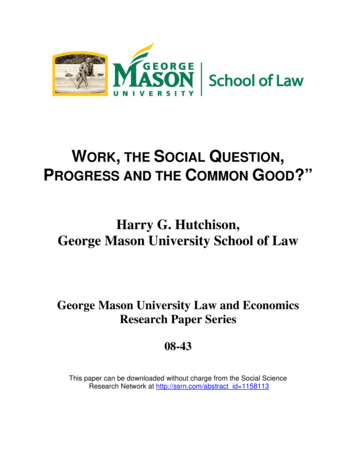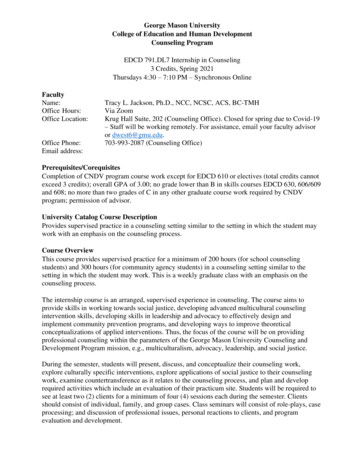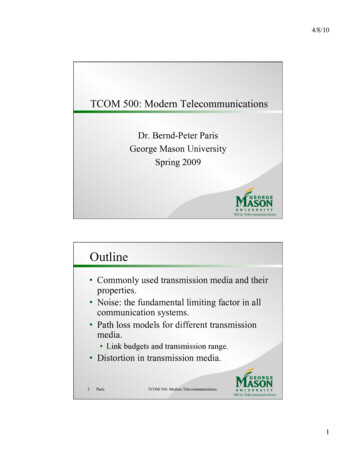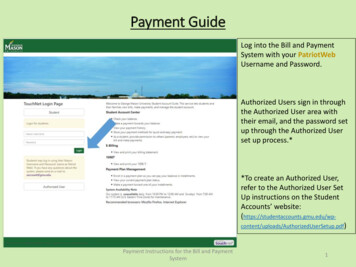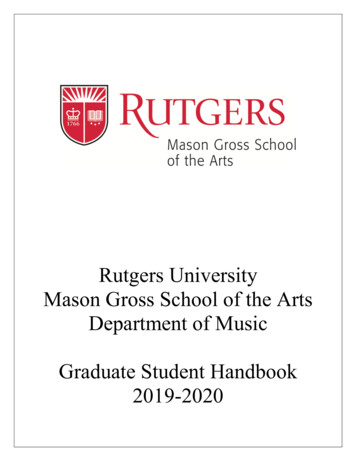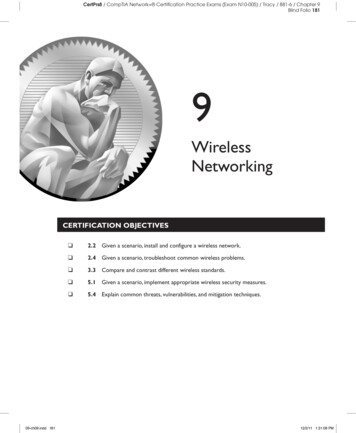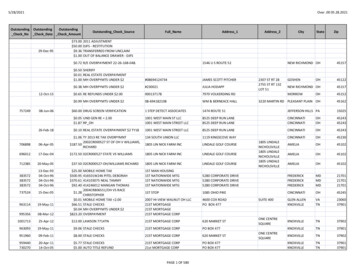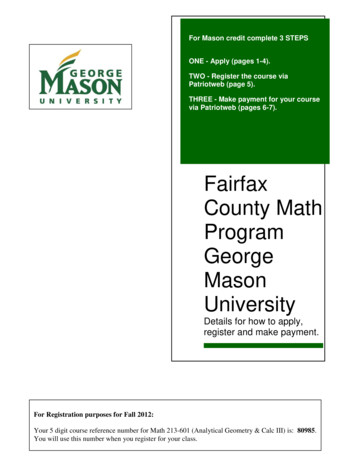
Transcription
AcknowledgementlSlides derived from class material postedby Dr. A. Goldsmithl www.stanford.edu/class/ee359/lectures.htmllSee also: A. Goldsmith, WirelessCommunications, Cambridge PressWireless HistoryllllAncient Systems: Smoke Signals, Carrier Pigeons, Radio invented in the 1880s by MarconiMany sophisticated military radio systems weredeveloped during and after WW2Exponential growth in cellular use since 1988:approx. 8B worldwide users todaylllllIgnited the wireless revolutionVoice, data, and multimedia ubiquitousUse in 3rd world countries growing rapidlyWifi also enjoying tremendous success and growthBluetooth pervasive, satellites also widespread1
Future Wireless NetworksUbiquitous Communication Among People and DevicesNext-Gen Cellular/WiFiSmart Homes/SpacesAutonomous CarsSmart CitiesBody-Area NetworksInternet of ThingsAll this and more ChallengeslNetwork/Radio Challenges 5l Gbps data rates with “no” errorsGShort-Rangel Energy efficiencylllllScarce/bifurcated spectrumReliability and coverageHeterogeneous networksSeamless internetwork handoffDevice/SoC ChallengeslllllllAdHocPerformanceComplexitySize, Power, CostHigh frequencies/mmWaveMultiple AntennasMultiradio CPUmmW2
What is the Internet of Things:lEnabling every electronic device to beconnected to each other and the InternetlIncludes smartphones, consumer electronics,cars, lights, clothes, sensors, medical devices, lValue in IoT is data processing in the cloudDifferent requirements than smartphones: low rates/energy consumptionAre we at the Shannonlimit of the Physical Layer?We are at the Shannon Limit “The wireless industry has reached the theoretical limit ofhow fast networks can go” K. Fitcher, Connected Planet “We’re 99% of the way” to the “barrier known as Shannon’slimit,” D. Warren, GSM Association Sr. Dir. of Tech.Shannon was wrong, there is no limit “There is no theoretical maximum to the amount of datathat can be carried by a radio channel” M. Gass, 802.11Wireless Networks: The Definitive Guidel“Effectively unlimited” capacity possible via personal cells(pcells). S. Perlman, Artemis.3
What would Shannon say?We don’t know the Shannoncapacity of most wireless channelsl Time-varyingchannels. Channels with interference or relays. Cellular systems Ad-hoc and sensor networks Channels with delay/energy/ constraints.Shannon theory provides design insightsand system performance upper boundsCurrent/Next-GenWireless SystemslCurrent:llllllll4G Cellular Systems (LTE-Advanced)4G Wireless LANs/WiFi (802.11ac)mmWave massive MIMO systemsSatellite SystemsBluetoothZigbeeWiGigEmergingllll5G Cellular and WiFi SystemsAd/hoc and Cognitive Radio NetworksEnergy-Harvesting SystemsChemical/MolecularMuch roomFor innovation4
Spectral ReuseDue to its scarcity, spectrum is reusedIn licensed bandsand unlicensed bandsBSCellularWifi, BT, UWB, Reuse introduces interferenceCellular Systems:Reuse channels to maximize capacityGeographic region divided into cellsFreq./timeslots/codes/space reused in different cells (reuse 1 common).Interference between cells using same channel: interference mitigation keyl Base stations/MTSOs coordinate handoff and control functionsl Shrinking cell size increases capacity, as well as complexity, handoff, lllBASESTATIONMTSO5
4G/LTE CellularlMuch higher data rates than 3G (50-100 Mbps)l 3Glsystems has 384 Kbps peak ratesGreater spectral efficiency (bits/s/Hz)l Morebandwidth, adaptive OFDM-MIMO,reduced interferencelFlexible use of up to 100 MHz of spectruml 10-20MHz spectrum allocation commonLow packet latency ( 5ms).l Reduced cost-per-bit (not clear to customers)l All IP networkl5G Upgrades from 4G6
Future Cellular PhonesBurdenfor thisperformanceis on the backbone networkEverythingwirelessin one deviceSan FranciscoBSBSLTE backbone is the ellularParisBSMuch better performance and reliability than today- Gbps rates, low latency, 99% coverage, energy efficiencyWifi NetworksMultimedia Everywhere, Without Wires802.11ac Streaming video Gbps data rates High reliability Coverage inside and outWireless HDTVand Gaming7
Wireless LAN Standardsl802.11b (Old – 1990s)llll802.11a/g (Middle Age– mid-late 1990s)llllStandard for 2.4GHz ISM band (80 MHz)Direct sequence spread spectrum (DSSS)Speeds of 11 Mbps, approx. 500 ft rangeStandard for 5GHz band (300 MHz)/also 2.4GHzOFDM in 20 MHz with adaptive rate/codesSpeeds of 54 Mbps, approx. 100-200 ft rangeManyWLANcardshave(a/b/g/n)802.11n/ac/ax (current/next gen)lllllStandard in 2.4 GHz and 5 GHz bandAdaptive OFDM /MIMO in 20/40/80/160 MHzAntennas: 2-4, up to 8Speeds up to 1 Gbps (10 Gbps for ax), approx. 200 ft rangeOther advances in packetization, antenna use, multiuser MIMOSatellite SystemslCover very large areaslDifferent orbit heightsllOptimized for one-way transmissionlllGEOs (39000 Km) versus LEOs (2000 Km)Radio (XM, Sirius) and movie (SatTV, DVB/S) broadcastsMost two-way systems went bankruptGlobal Positioning System (GPS) ubiquitousSatellite signals used to pinpoint locationl Popular in cell phones, PDAs, and navigation devicesl8
BluetoothlCable replacement RF technology (low cost)lShort range (10m, extendable to 100m)l2.4 GHz band (crowded)l1 Data (700 Kbps) and 3 voice channels, upto 3 MbpslWidely supported by telecommunications,PC, and consumer electronics companieslFew applications beyond cable replacement8C32810.61-Cimini-7/98IEEE 802.15.4/ZigBee RadioslLow-rate low-power low-cost secure radiollllllllComplementary to WiFi and BluetoothFrequency bands: 784, 868, 915 MHz, 2.4 GHzData rates: 20Kbps, 40Kbps, 250 KbpsRange: 10-100m line-of-sightSupport for large mesh networking or star clustersSupport for low latency devicesCSMA-CA channel accessApplications: light switches, electricity meters,traffic management, and other low-power sensors.9
Spectrum RegulationlSpectrum a scarce public resource, hence allocatedlSpectral allocation in US controlled by FCC(commercial) or OSM (defense)lFCC auctions spectral blocks for set applications.lSome spectrum set aside for universal uselWorldwide spectrum controlled by ITU-RlRegulation is a necessary evil.Innovations in regulation being considered worldwidein multiple cognitive radio paradigmsAdvanced Topics LectureEmerging SystemsllllllllllNew cellular system architecturesmmWave/massive MIMO communicationsSoftware-defined network architecturesAd hoc/mesh wireless networksCognitive radio networksWireless sensor networksEnergy-constrained radiosDistributed control networksChemical CommunicationsApplications of Communications in Health, Biomedicine, and Neuroscience10
Rethinking “Cells” in CellularCoopMIMOSmallCellRelayDASlHow should cellularsystems be designed for- Capacity- Coverage- Energy efficiency- Low latencyTraditional cellular design “interference-limited”llllllMIMO/multiuser detection can remove interferenceCooperating BSs form a MIMO array: what is a cell?Relays change cell shape and boundariesDistributed antennas move BS towards cell boundarySmall cells create a cell within a cellMobile cooperation via relays, virtual MIMO, network coding.mmWave Massive MIMOç10s of GHz of SpectrumèDozens of devicesHundredsof antennaslmmWaves have large non-monotonic path losslllllChannel model poorly understoodFor asymptotically large arrays with channel state information, noattenuation, fading, interference or noisemmWave antennas are small: perfect for massive MIMOBottlenecks: channel estimation and system complexityNon-coherent design holds significant promise11
Software-Defined Network ArchitecturesVehicularApp ThresholdNetwork OptimizationUNIFIED CONTROL PLANEDistributed AntennasWiFiCellularHW layermmWave Ad-HocNetworksAd-Hoc NetworkslPeer-to-peer communicationslllllNo backbone infrastructure or centralized controlRouting can be multihop.Topology is dynamic.Fully connected with different link SINRsOpen questionslllFundamental capacity regionResource allocation (power, rate, spectrum, etc.)Routing12
Cognitive RadiosCRTxIPNCRNCRCRMIMO Cognitive UnderlaylCRNCRTxCRRxNCRRxCognitive OverlayCognitive radios support new users in existingcrowded spectrum without degrading licensed usersUtilize advanced communication and DSP techniquesl Coupled with novel spectrum allocation policiesllMultiple paradigms(MIMO) Underlay (interference below a threshold)l Interweave finds/uses unused time/freq/space slotsl Overlay (overhears/relays primary message whilecancelling interference it causes to cognitive receiver)lDistributed Control over WirelessAutomated Vehicles- Cars- Airplanes/UAVs- Insect flyersInterdisciplinary design approach Control requires fast, accurate, and reliable feedback.Wireless networks introduce delay and lossNeed reliable networks and robust controllersMostly open problems : Many design challenges13
lCable replacement RF technology (low cost) lShort range (10m, extendable to 100m) l2.4 GHz band (crowded) l1 Data (700 Kbps) and 3 voice channels, up to 3 Mbps lWidely supported by telecommunications, PC, and consumer electronics companies lFew applications beyond cable replacement IEE
